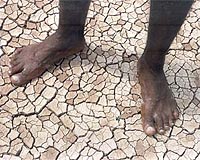 |
Paris (AFP) Sept 7, 2009 Most of sub-Saharan Africa and South Asia are facing extreme or high risk of food shortages, according to a ranking of 148 nations obtained by AFP on Monday. The United States is least at risk followed by France, Canada, Germany and the Czech Republic, according to the Food Security Risk Index, calculated from dozens of variables that determine a country's capacity to feed its people. Food stress jumped toward the top of the global agenda after soaring commodity prices in 2007 and 2008 sparked riots in 30 countries, including many tottering on the brink of severe shortages or widespread hunger. The World Bank estimates that food inflation during that period pushed an additional 100 million people into deep poverty, on top of a billion that were already scraping by on less than a dollar a day. Poverty is a major source of food vulnerability but not the only one, said the study by Maplecroft, a Britain-based firm that provides risk intelligence for businesses. "Food security is also affected by agricultural development, trade flows, foreign aid as well as government policies on nutrition," said Alyson Warhurst, a professor at Warwick Business School in central England and co-director of Maplecroft. "Added to these are the impacts of population growth and climate change," she told AFP. The five countries topping the risk list -- Angola, Haiti, Mozambique, Burundi and Democratic Republic of Congo -- are all mired in poverty, but other factors also boost vulnerability. Nearly three decades of civil war in Angola has displaced millions and wreaked havoc on agricultural infrastructure. DR Congo and Burundi have also been ravaged by conflict, along with corruption and poor governance. Mozambique is, in addition, buffeted by weather-related natural disasters, while politically unstable Haiti depends on foreign aid for nearly half of its food needs. The three most populous countries in South Asia also face food precariousness: Pakistan, ranked 11th on the index, is at "extreme risk," while Bangladesh and India are both at "high risk," ranked 20th and 25th respectively. "India may be one of the world's key emerging economies, but it is finding itself under increasing pressure from food security issues," the report concluded. Two-thirds of India's 1.1 billion people depend on farming as their main income source. But acreage of land under cultivation has dropped by more than a fifth since August last year, due to dwindling water resources, deforestation and an uneven rainy season in July this year. The Indian government has said it will soon publish its own National Food Security Act to insure adequate distribution of food. "But the Indian government will need to overcome challenges to distribution as well as financing the subsidies," said Fiona Place, a senior risk analyst at Maplecroft. China, Russia and Brazil -- the other three so-called BRIC major emerging economies -- all face medium risk, ranking between 100 and 114 on the index. In China, food self-sufficiency and avoiding price and supply shocks have long been national policy. In addition, Beijing has in recent years bought huge tracts of arable land in Africa to grow staple crops for consumption back home. The United States and France rank highest in food security in large measure due to their status as the world's top two exporters of cereals, the study reported. Share This Article With Planet Earth
Related Links Farming Today - Suppliers and Technology
 Millions face starvation in EAfrican drought
Millions face starvation in EAfrican droughtNairobi (AFP) Sept 3, 2009 A sweeping drought across East Africa has left millions of people at risk of starvation, in a region plagued by increasingly erratic rainfall, humanitarian organisations and officials warn. Huge food shortages and loss of livelihood has left 6.2 million Ethiopians needing relief aid, while about 3.8 million in Kenya's arid areas, where livestock is being decimated, have also been affected ... read more |
|
| The content herein, unless otherwise known to be public domain, are Copyright 1995-2009 - SpaceDaily. AFP and UPI Wire Stories are copyright Agence France-Presse and United Press International. ESA Portal Reports are copyright European Space Agency. All NASA sourced material is public domain. Additional copyrights may apply in whole or part to other bona fide parties. Advertising does not imply endorsement,agreement or approval of any opinions, statements or information provided by SpaceDaily on any Web page published or hosted by SpaceDaily. Privacy Statement |